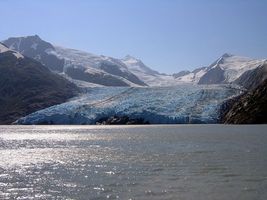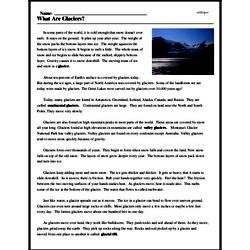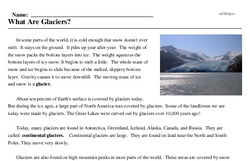What Are Glaciers?
In some parts of the world, it is cold enough that snow doesn't ever melt. It stays on the ground. It piles up year after year. The weight of the snow packs the bottom layers into ice. The weight squeezes the bottom layers of icy snow. It begins to melt a little. The whole mass of snow and ice begins to slide because of the melted, slippery bottom layer. Gravity causes it to move downhill. The moving mass of ice and snow is a glacier.
About ten percent of Earth's surface is covered by glaciers today. But during the ice ages, a large part of North America was covered by glaciers. Some of the landforms we see today were made by glaciers. The Great Lakes were carved out by glaciers over 10,000 years ago!
Today, many glaciers are found in Antarctica, Greenland, Iceland, Alaska, Canada, and Russia. They are called continental glaciers. Continental glaciers are large. They are found on land near the North and South Poles. They move very slowly.
Glaciers are also found on high mountain peaks in most parts of the world. These areas are covered by snow all year long. Glaciers found at high elevations in mountains are called valley glaciers. Montana's Glacier National Park has valley glaciers. Valley glaciers are found on every continent except Australia. Valley glaciers tend to move more quickly because of gravity.
Glaciers form over thousands of years. They begin to form when snow falls and covers the land. New snow falls on top of the old snow. The layers of snow grow deeper every year. The bottom layers of snow pack down and turn into ice.




